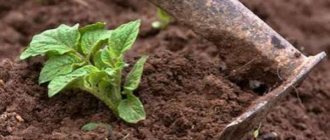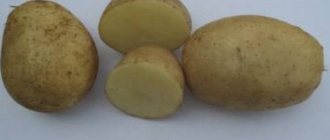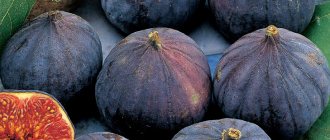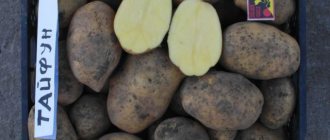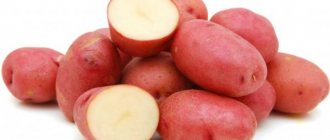Vegetable growing » Potatoes
0
1346
Article rating
Kira Stoletova
The Black Prince potato variety is one of the brightest types of dark vegetables. The variety is surprising for its even shapes and sizes. It has delicious taste and amazing aroma. The variety is not very productive, is not difficult to care for and does not get sick. The fruits can be sold, but black potatoes are mainly grown for home use.
Description of the potato variety Black Prince
Breeding dark potatoes
Experts say that dark potatoes came to Russia from the countries of South America - this crop is grown especially actively here. Today, our gardeners who crave something exotic in their garden plots are offered, in addition to the “Black Prince”, the following varieties of potatoes:
- "Purple Viking";
- "Negress";
- "Chinese truffle"
But the exact origin of the Black Prince variety is unknown. There are only hypotheses. It is assumed that this variety was bred by Dutch or Israeli breeders. There is also an opinion that several similar varieties are combined under one name. “The Black Prince” cannot be found in the State Register of Cultures of the Russian Federation - it is not included here. Nevertheless, the variety is very popular among gardeners from different countries.
Table 1
| Characteristics of the variety “Black Prince” | |
| Maturation category | mid-early |
| Maturation period, days | 90 |
| Starch, % | 12-16 |
| Mass of tubers, g | 70-170 |
| Number of tubers in one bush, pieces | 5-7 pieces |
| Productivity, c/ha | up to 100 |
| Tuber shape | oval, slightly elongated |
| Peel color | dark purple |
| Flesh color | light beige |
| Consumer qualities | good taste, balanced, not watery, after cooking the tubers retain a pleasant potato aroma |
| Keeping quality % | 97 |
| Growing regions | cultivated in all regions |
| Attitude to diseases | resistance to potato blight, golden nematode, common scab |
| Appearance of bushes | tall, erect, with moderately spreading branches |
| Appearance of leaves | medium-sized, light green, wavy edges |
| Bloom | corolla of large bluish flowers, low berry production |
| Degree of foliage | average |
The yield of dark potatoes is low, no more than 7 tubers per bush. But they are all large - the variety practically does not produce non-marketable small potatoes.
Since the variety is not characterized by productivity, it is grown only as an addition to other potato varieties, planting part of the plot. The tubers of the “Black Prince” are quite beautiful - smooth, unusually colored, with a moderately thin and smooth skin. The eyes are shallow - they do not interfere with cleaning the tubers.
Advantages and disadvantages
The yield of the Black Prince is high. From one bush you get more than one and a half kilograms of finished vegetables. Every year, yields can vary depending on weather conditions, as well as on the adaptability of the variety to the planting site. Once every 5-10 years, it is better to transplant potatoes to another place, since the substances necessary for growth are periodically used up, and the yield decreases as a result. Fruiting is increased with the use of additional nutrients suitable for potatoes.
Advantages of the Black Prince over other potato varieties:
- An appetizing aroma that lasts even after cooking.
- Great looks.
- It can be stored for a long time in the cellar, in the refrigerator, without losing taste and vitamins.
- Resistance to diseases common among potatoes.
- Adaptation to changes in environmental conditions - drought, excessive humidity.
- An abundance of vitamins and minerals that are preserved even after cooking.
- No damage during transportation.
- Easy to care for.
However, the Black Prince also has disadvantages that put it in a negative light relative to other potato varieties:
- Susceptible to diseases: late blight and blackleg can lead to complete loss of the crop.
- Not suitable for sowing throughout the garden, since such a large number of potatoes stimulates soil depletion.
- Dependence of yield on environmental conditions.
The variety is suitable for growing in almost any type of soil and does not require special care, which makes it a welcome guest in the garden.
Comparison with other varieties
To evaluate the consumer qualities and characteristics of the Black Prince potato, let’s compare it with other popular varieties. Table 2 shows a comparison of yield and shelf life, and Table 3 shows a comparison of starch content.
table 2
| Variety name | Productivity, c/ha | Keeping quality, % |
| Black Prince | up to 100 | 97 |
| Queen Anne | 390-460 | 92 |
| Sifra | 180-400 | 94 |
| Mozart | 200-330 | 92 |
| Vector | 670 | 95 |
| League | 210-360 | 93 |
| Milena | 450-600 | 95 |
| Elmundo | 250-345 | 97 |
| Serpanok | 170-215 | 94 |
The taste of tubers and their digestibility depend on the starch content. “Black Prince” does not darken when cut, and does not boil over when cooked, becoming tender and crumbly. You can make lush mashed potatoes, french fries, fry, stuffing, and bake from tubers.
Table 3
| Variety name | Starch content, % |
| Black Prince | 12-16 |
| Santana | 13-17 |
| Desiree | 13-21 |
| Openwork | 14-16 |
| Purple Haze | 14-17 |
| Yanka | 13-18 |
| Tuscany | 12-14 |
| Artemis | 13-16 |
| Sheri | 11-15 |
| Svitanok Kyiv | 18-19 |
| Cast iron | 12-15 |
Features of agricultural technology
The agricultural technology of black potatoes is not much different from ordinary ones. Timely watering is very important, because the future yield of the variety depends on it.
Whatever the care, such will be the harvest.
Potatoes should be watered during the following periods:
- budding;
- flowering;
- after flowering.
Watering is done at the root. It’s good if you can organize drip irrigation, but you can moisten the soil in the traditional way.
Top dressing
The first application of fertilizers to potato rows is made when small bushes are formed.
- When planting , you can add wood ash to each hole.
- The second feeding is done after 2 weeks. For this, urea or mullein solution is used.
- The third fertilization of the soil is carried out immediately after flowering. To do this, potatoes are spilled with a solution of potassium sulfate (500 mg per bush). Depending on the “poorness” of the soil, the amount of fertilizing can be increased.
Weeding
The first weeding is carried out as weeds appear, usually combined with hilling.
And also don’t forget about regular weeding.
Weeds draw large amounts of nutrients from the soil, so crops are often delayed in growth and development due to deficiency.
In addition, weeds are the habitat of many pests that can spread to potato crops.
Loosening
Loosening prevents the formation of a hard crust on the surface of the earth and destroys emerging weed seedlings.
Loosening the soil is necessary for 2 reasons:
- Providing oxygen access to the soil.
- Breaking the crust formed after watering.
During the loosening process, weeding can also be carried out.
Hilling is also an important agrotechnical technique in the process of caring for potatoes. Hilling improves aeration and eliminates some pests and diseases.
- The first hilling is carried out when the bush reaches a height of 15–20 cm.
- The second and third - every 2-3 weeks.
The benefits of dark potatoes
Potatoes with dark skin are interesting for cooks and gourmets. The tubers contain:
- minerals;
- vitamins;
- phenolic acids;
- antioxidants;
- anthocyanins;
- carotenoids.
The effect of eating purple potatoes daily:
- slowing down aging;
- improving the functioning of the gastrointestinal tract and cardiovascular system;
- restoration of vision.
But dark root vegetables also contain harmful substances. For example, solanine is a natural poison found in small quantities in any potato. If potatoes are stored incorrectly, the concentration of solanine increases. Green areas should be cut off without sparing.
Positive and negative traits
The variety is not very common, but is promising for homesteads and small farmlands due to its properties:
- collected root crops are stored well until the beginning of spring;
- potatoes have a pronounced pleasant smell;
- excellent taste;
- high marketability of the crop;
- versatility in cooking
The Black Prince is not very resistant to diseases and harmful insects.
Soil preparation
Preparing soil for potatoes can be divided into two stages:
- Autumn. The soil for potato plantations is prepared in the fall. The land allocated for potatoes is dug up. It is recommended to apply fertilizer during autumn digging, then you won’t have to do it in the spring. For each square meter - 10 kg of humus and 200-300 g of wood ash. Some gardeners sow green manure on the plot - rye, oats, etc., which are plowed in the spring.
- Spring. In April-May, dolomite flour or complex mineral fertilizers are added to the soil. They do the digging again. To increase productivity, humus and ash are added directly to the holes.
If potatoes are planted in an area with heavy soils and frequent stagnation of moisture, it is necessary to use the ridge method.
Disease resistance
May be interesting Potato nematode: description of the disease, how to fight it, prevention Reasons why potato leaves turn yellow and what to do in this situation Digging potatoes with a walk-behind tractor: step-by-step instructions, pros and cons, video
An important advantage is that the variety is not susceptible to most diseases. While in the same field as the Black Prince, potatoes are dying from golden nematode, potato cancer and common scab. To increase the resistance of the variety to other diseases, it is recommended to use preventive methods of control:
- Treating the planting area with copper-containing products.
- Sprinkling the area with wood ash. Protects against diseases, acting as a preventive measure against pests.
- Calcium treatment. Calcium forms a protective system around the tubers that prevents the entry of bacteria.
Diseases to which the Black Prince has a pronounced immunity:
- root rot;
- potato cancer;
- late blight
Black Prince, like other potato varieties, often suffers from attacks by various insects: from Colorado potato beetles to wireworms.
Advice!
To get rid of and protect against insects, potatoes need to be treated with special means - Lightning, Regent, Commander, Taboo.
The Black Prince copes with unfavorable environmental conditions quickly and easily. The plant has no special care requirements.
Preparing potatoes for planting
Rules for preparing potatoes for planting:
- Healthy medium-sized tubers with a rich dark color are selected for planting. Seed material is selected during harvesting. In the spring, the tubers are sorted again - diseased potatoes that have not overwintered are removed.
- 2-4 weeks before planting, seed potatoes are placed in a lighted place for germination. Root vegetables need to be greened. In the light, they accumulate poison - corned beef, which repels rodents.
- Treat the tubers with “Fitosporin” or a solution of copper sulfate. You can also soak the tubers in a growth stimulator.
Correct fit
Planting the variety does not require any special techniques. For sowing, you need to select healthy medium-sized tubers. It is desirable that these are very dark specimens. A couple of weeks before planting, place the potatoes in the sun so that the tubers sprout. You can treat them with lime or calcium in advance to prevent insects from eating them.
Potatoes must be planted in small holes up to 10 cm deep. The distance between plantings should be at least 40 cm. For better effect, you can add fertilizer to the planting hole. If the soil is too dry, it can be further moistened before planting.
To care for the variety it is enough:
- Ensure timely watering during dry summers.
- Hill up potatoes 3-4 times per season. The procedure improves potato ventilation and provides oxygen access to the tubers.
- Weed as the grass becomes overgrown.
- Treat against the Colorado potato beetle and other pests. Lightning and Commander are suitable for this.
There is no need to trim and fertilize potatoes while they are growing. After digging, it is important to collect all the tops and old potatoes so that the soil on which it is planned to grow next year is not contaminated.
To store potatoes for a long time, a dry and dark place - a cellar - is suitable. To prevent potatoes from sprouting, you can lay them in layers through a special wooden spacer. Before harvesting potatoes, they must be sorted - it is recommended to eat cut and damaged tubers as soon as possible. Divide the remaining potatoes into those suitable for eating and for planting.
We invite you to familiarize yourself with the Pinova Apple Tree: description, photos, reviews
Advice!
In autumn and spring, when the air temperature increases, bottles of ice can be placed in potato storage areas. Such steps will save you from rotting.
Seed potatoes must be exposed to the sun 2-3 weeks before planting for germination.
The main enemy of storing potatoes is moisture. To get rid of it, it is recommended to ventilate the room, install a dehumidifier or lay a layer of special material that absorbs moisture.
In winter, to protect the tubers from frost, it is recommended to cover them with straw or clean bags made of natural materials. Regularly inspect the total mass for rotting. If you notice several spoiled ones, throw them away immediately so as not to cause an “epidemic of rotting” among other potatoes.
Seed treatment
The root color is black and does not require any special care procedures. Everything is done the same as with ordinary potato varieties.
Any potato needs timely watering. The future harvest depends on how the moisture supply is carried out. Summer residents advise organizing drip irrigation. But in its absence, water as needed using the usual methods.
The plant requires abundant watering:
- at the moment of budding;
- during the flowering period;
- after it blooms.
Ensuring the supply of moisture will lead to the stated volume of yield.
Top dressing
The plant does not refuse to apply fertilizers. No matter how fertile the land is, fertilizing is mandatory. For the first time, on the 14th day after germination, liquid mullein or urea is used.
The second mandatory feeding is immediately after the potatoes have flowered. Then water with potassium sulfate at the rate of 500 mg per 1 bush.
If there is time and opportunity, the amount of fertilizing is increased.
Weeding
Removing weeds is a mandatory process when growing any crop. This is especially important at the initial stage, when the plant requires the maximum amount of nutrients from the soil. And weeds pull out from the soil most of the minerals that potatoes need for full development.
Another reason to pull out weeds is that they are carriers of diseases and pests.
Loosening the soil
The root system of plants needs a constant supply of oxygen. That's why summer residents loosen their beds. Breaking the crust formed after rain or watering.
Before emergence, the soil is loosened shallowly, this allows the tubers to breathe and develop faster. In addition, it reduces the amount of weeds.
Hilling
Mandatory procedure when growing crops. This protects against the appearance of pests, the development of certain diseases and improves soil aeration. This is done for the first time when the plant reaches 15-20 cm in height. Then 2 more times, until the potatoes finally grow, and this becomes difficult.
Why potatoes may turn black inside during the growing stage:
- Too much nitrogen in the soil, or potassium deficiency. Also, undiluted organic matter added to the soil can cause darkening of the pulp; potatoes do not like the introduction of concentrated products;
- During cultivation, mistakes were made in watering; this could be either overwatering or underwatering;
- The harvest was harvested either too early or, conversely, late. In the first case, the tubers simply do not have time to ripen; in the second, they spend too long in the warm soil and rot.
Agricultural technology for this potato is standard. For planting, medium-sized tubers are selected that are smooth, not sick, and not damaged by insect pests: wireworms or mole crickets. It is advisable to use root vegetables with pronounced varietal qualities: bright pulp, extremely dark skin, small eyes. Such selection will help to obtain a high-quality harvest and protect the variety from degeneration and erosion.
Depending on the climate and soil composition, potatoes can be planted in trenches or in the traditional way. The first is ideal for light sandy soils. When planting in loam or black soil, it is better to place the tubers in holes located at a distance of 30 cm from each other. The depth does not exceed 10 cm.
Important: Before planting, selected tubers are pickled, treated with a growth stimulant, and then germinated in the light or in wet sawdust. All manipulations are carried out 4 weeks before planting.
Potatoes are drought-resistant, but with proper soil moisture, the yield increases and the tubers are larger. Drip irrigation combined with sprinkling is recommended.
When the sprouts reach a height of 20 cm, they are hilled, forming high ridges. Subsequently, hilling is carried out 1-2 more times, this improves soil aeration and protects the bushes from pests. Mulching will help control weeds.
The variety is sensitive to the nutritional value of the soil, which means the potatoes need to be fertilized. It is recommended to feed at least 2 times during the planting season. In the first phase, diluted mullein or an aqueous solution of urea is used.
After flowering, the bushes are fertilized with potassium sulfate. Each bush should contain about 500 ml of the finished solution. Root feeding is also possible. The bushes are sprayed with an aqueous solution of superphosphate 10-12 days before digging up the crop. The procedure helps the tubers become larger and more beautiful.
For more information about what, when and how to feed potatoes, and how to do it correctly when planting, read additional articles on the site.
Characteristics:
- Refers to mid-early table varieties. The crop matures completely in 90 days;
- Harvest 100 centners per hectare;
- Requirements for soil nutrition.
Dates and methods of planting
Exotic potatoes do not require any special planting. This variety is unpretentious, its cultivation is accessible even to novice gardeners. It is enough to follow the standard rules of agricultural technology. Things to remember when planting any potatoes:
- The planting site is chosen in a well-lit area, without drafts and protected from flooding.
- The optimal planting time is determined by the soil temperature - it should reach +7-12⁰С. The landing time for each region is different, in addition, specific weather conditions must be taken into account.
Planting methods:
- Standard. In areas where there is no stagnation of moisture, potatoes are planted in rows. The tubers are placed in holes or dug trenches. Planting parameters: distance between tubers – 20-30 cm;
- hole depth – 10 cm;
- distance between rows – 70 cm.
Planting and growing Black Prince potatoes
The Black Prince is an unpretentious variety, but planting and cultivation require compliance with certain features. It is recommended to prepare the soil and planting material.
Preparing for landing
Tubers for planting should be black, medium in size, without signs of disease or damage. It is better not to take small fruits.
For a couple of weeks, the planting material is left in the light for germination, then treated with special agents against pests and diseases.
Soil requirements
The Black Prince loves sandy soil, but will grow and bear fruit on loamy, sandy loam and other soil. It is best to choose loose soil.
Lighting does not play an important role, but the groundwater level is better to be below the planting level. This will avoid rotting of roots and tubers.
Growing Potatoes
Dates, scheme and rules of planting
It is recommended to plant the variety in the second half of April or the first half of May. The main thing is that the soil warms up to at least +7 degrees.
Planting is carried out in small holes to a depth of no more than 10 cm. A distance of approximately 50 cm is left between plants.
Important! To obtain a better harvest, fertilizers (ash, humus) are added to the hole when planting.
If the soil is quite dry, it is worth moistening it before planting the tubers.
Rules of care
For the development and formation of large root crops, purple potatoes need a standard set of agrotechnical measures:
- Watering. The variety loves timely moisture. It requires abundant watering to grow. The best option is to organize drip irrigation. The number of waterings depends on weather conditions. In favorable weather, three waterings may be sufficient: when seedlings appear;
- when buds appear;
- when the potato bushes fade.
- 1st feeding – 2 weeks after emergence. Add diluted, semi-liquid mullein or urea - 1 tbsp. l. on a bucket. 500 ml of fertilizer is used for each bush.
How to properly care for the variety
The Black Prince does not require special care, but it is recommended to follow some rules. This will help you get a richer harvest.
Features of watering
The variety is considered elite and requires good watering. A combination of drip irrigation and sprinkling is best. However, despite the “love” for moisture, the variety will calmly tolerate dry weather.
Under favorable climatic conditions, three irrigations are sufficient:
- when sprouts appear,
- during the formation of buds,
- after flowering ends.
Feeding and fertilizing
The variety responds well to various feedings. The first is carried out a couple of weeks after the sprouts appear. For this purpose, urea or manure is used.
The next feeding is carried out after flowering. In this case, mineral fertilizers are suitable.
Hilling and weeding
To provide the plant with nutrients and saturate the soil with fresh air, periodically loosening and weeding are carried out, and weeds are constantly removed.
Main pests and measures to combat them
The most damaging things that damage purple potatoes are Colorado potato beetles and wireworms—the larvae of the click beetle that gnaw tunnels in the tubers. In addition to treatment with chemical and biological preparations, in the fight against all pests it is recommended to resort to agrotechnical measures:
- mulching the rows with straw, sawdust or mown grass (read more about mulching the soil here);
- timely removal of weeds.
Table 5
| Potato pest | Control measures |
| Colorado beetle |
|
| Wireworm |
|
| Flying insects - potato moth and others. |
|
The most effective drugs against the Colorado potato beetle are Aktara, Regent, Corado, Prestige, Commander, Lightning, Apache, Tanrek, Taboo.
Dangerous diseases and measures to combat them
The variety is resistant to most potato diseases, but it may not resist late blight. "Black Prince" can also be affected by blackleg and ring rot. Disease control measures are in Table 6.
Table 6
| Potato disease | Prevention measures | Control measures |
| Late blight |
| At the first signs of late blight, the bushes are dug up and destroyed. |
| Ring rot |
| Treatment with complex action insecticides - Shar Pei, Sirocco, Tanrek and others. |
| Blackleg |
|
|
Pre-planting treatment of tubers will help prevent many diseases:
- Autumn treatment of seed material with the drug "Maxim KS" - 0.2 ml per 1 kg. Or spring - 0.4 ml per 1 kg.
- Treatment with any bacterial preparation. For example, “Fitosporin” - 0.4-0.5 kg/t, “Baktofit” - 3-5 kg/t, “Integral” - 2 l/t.
Sign of illness
In some cases, black potato tubers are not an indicator of the variety, but the result of a disease, attack by microorganisms and fungi. This is a serious problem. To prevent infection of the entire crop, you need to make the correct “diagnosis” and know how to properly deal with a particular disease.
Melanosis is a disease in which dark gray areas form in the flesh. It arises due to the scarcity of the soil, a lack of potassium and an excess of nitrogen. Also, “bruises” in tubers appear due to improper handling, when the crop is thrown too much or is often poured over. To avoid this, it is necessary to strictly follow the recommended proportions when applying fertilizers and carefully transport the tubers.
You can also dig up potatoes with black flesh for bacterial diseases such as blackleg or ring rot.
Blackleg is a disease of the stems, but from the sides the bacterium can penetrate into the tuber itself. As a result of its vital activity, the pulp first becomes black and smells bad, and then the tuber completely rots. If it is not removed in a timely manner, the disease will spread to neighboring specimens.
Ring rot provokes rotting under the skin, as if along a ring of pulp. If you press on the affected tuber, mucus with a foul odor will be released. Such potatoes are not suitable for human consumption.
To avoid bacterial infections, it is recommended to treat tubers with special preparations (Prestige, Baktofit and their analogues) before planting in the ground. Diseased bushes and potatoes should be ruthlessly destroyed, and the storage should be etched with copper sulfate. But the most reliable method is to use varieties that are resistant to bacterial diseases.
There are potatoes with black spots caused by fungi. The following common diseases can be identified in this category:
- Alternaria blight;
- different types of scab;
- late blight;
- Phomasis;
- fusarium;
- potato cancer.
Alternaria blight is a rare fungal disease in which dark areas in the form of concentric circles appear on the peel. When cut into the flesh, depressed dark spots are visible.
Late blight is a very dangerous fungal disease of potatoes. Dark spots appear on the tubers, leading to rotting.
Different types of scab manifest themselves in different ways:
- Black scab is small black spots in the form of a network.
- Common scab appears as dark sores.
- Powdery scab is distinguished from other types by star-shaped sores. They are dry and have a brown tint.
- Silver scab is a coating of silvery sheen with a metallic tint.
- Lumpy scab appears as raised black pustules.
How to deal with this scourge? The drugs Maxim and Prestige cope well with scab. These means need to treat the seed material before planting in the ground, then the new crop will no longer be infected with the fungus.
Fomoz is another unpleasant disease. It is also called button rot. A dark brown spot forms on the surface of the tuber, causing the pulp to rot. Rotting tissue is easily separated from the healthy part with your fingers.
Fusarium - dry rot. When damaged, a section of the tuber rots, collapses and becomes rotten. When tactilely applied, the affected part crumbles like dust from a stump.
Potato cancer . When cancer attacks potatoes, the black skin becomes covered with ugly growths. This is the most dangerous disease. In those gardens where the fungus of this disease has been identified, the crop cannot be grown for 6 years. To prevent fungi from attacking potatoes, preventive measures must be taken in a timely manner. They are the same as for bacterial infections.
How to harvest and store crops without loss?
Collection of purple tubers can begin 2-2.5 months after planting. What you need to know:
- A week before harvesting, mow all the tops.
- Before storing the tubers, they are dried for 1-2 hours in the sun.
- This variety is convenient because it does not require sorting - all tubers grow the same size. “Black Prince” does not produce small potatoes.
- After drying, the tubers are laid out in boxes and placed in a dry, dark place. You can sprinkle a little sawdust on top - it will protect the root crops from excess moisture.
Harvest and storage
Before harvesting, it is necessary to mow the tops. This is done approximately 10–12 days before harvesting.
Black potatoes are stored under the same conditions as the varieties we are used to.
At the same time, all the nutrients aimed at the growth of greenery will go to the development and improvement of the quality of root crops.
After harvesting, the potatoes are dried, sorted, sorted and only then stored. Black potatoes are stored at minimal humidity, in a cool, dark room.
Reviews from gardeners
For farmers, dark potato varieties are not of particular interest - they have low yields, and this factor is decisive for industrial production. But amateur gardeners always enjoy experimenting by planting unusual varieties of vegetables, including dark “Black Prince” potatoes.
★★★★★
Lidiya Nikolaevna (Kursk). We call purple potatoes Negro or Gypsy.
Potatoes are very tasty, but they require care - if you don’t water them, there will be no harvest. I have not considered this variety exotic for a long time; I have been growing potatoes with dark skin for a long time - I like its taste, aroma and appearance ★★★★★
Valentina, Novosibirsk. This variety of soot is for the soul - pleasing to the eye and taste buds.
For mass harvesting, I plant more productive and unpretentious varieties. “Black Prince” is wonderful fried and baked. Hide
Add your review
“Black Prince” attracts gardeners both in appearance and in its taste. The variety grows well in cold and rainy weather, which cannot but interest vegetable growers from regions with cool summers.
0
0
Copy link
Description of the variety
Black Prince.
Purple Peruvian.
Black woman.
Chinese truffle.
Scottish black.
Purple Viking.
What is this species? The light ground part contrasts sharply with the dark skin of the root crops. The height of an erect, lush bush depends on the variety. On average, it is 50–60 cm.
Today in Russia black potatoes are represented by the following varieties:
- "Scottish black";
- "Negress";
- "Chinese truffle";
- "Black Prince";
- "Purple Peruvian."
The regions for cultivating black potatoes are not limited by rigid boundaries . It can be grown both in the middle zone and in the Far East.
Roots
The flesh of black potatoes is actually not black at all, but purple, and there are often light veins.
- Root vegetables of this species are notable not only for their black or purple color, but also for the unusual shade of the pulp - bright purple. When cut, light streaks are visible.
- The shape of potatoes, depending on the variety, can be oblong-oval or round.
- The skin is dense and thick, which has a good effect on the shelf life.
- The average length of the root crop is 8–10 cm, weight – 70–80 g.
Black potatoes contain antioxidants and many vitamins.
Unique author's recipes
Delicious open-faced potato and sausage pie
Healthy baked potatoes with kohlrabi and carrots
The taste is similar to regular potatoes with a bright nutty flavor. Root vegetables cook quite quickly, the shade of the pulp and peel is preserved during heat treatment. Black potatoes can be fried , baked and boiled . Dishes made from it are very unusual both in color and taste.
Growing regions
This plant is grown throughout almost the entire populated part of the globe, with the possible exception of the Far North. This is due to the fact that the vegetable easily tolerates both wet and dry climatic conditions.
Distribution in Russia
Black potatoes have become widespread in Russia in recent years. Summer residents and gardeners in most regions are familiar with crop varieties. However, as noted, the vegetable is not grown as a main table crop.
A guide to the experience of experienced gardeners
If you remove the sprouts from the tubers in time, they will be stored longer and will not turn green.
As for the resistance of black potatoes to parasites, we will have to disappoint readers a little. The rich taste, abundance of vitamins and other substances that are important for us in the tubers make them extremely attractive to a variety of pests. Therefore, in order to get a high-quality harvest, you will have to fight parasites a little more actively than usual. Otherwise, black potatoes do not require any special care.
Instead of concluding, let’s say that black potato varieties, like any other, have their advantages and disadvantages. So, you should definitely pay attention to it, if only because of its beneficial properties and unusual taste. Although, of course, due to low yields and exposure to parasites, growing it on an industrial scale will be quite unprofitable.
Potato care
To care for potatoes, you will need the following steps:
- Removing weeds or weeding is an integral part when working with vegetable crops. It is carried out with each new shoot of grass, but at least three times during the summer season.
- When weeding, you need to not only remove excess vegetation around the bush, but also fluff up the soil - this helps enrich the soil with oxygen.
- Affects fruitfulness and hilling . You need to wait until the bush rises to a height of 20–30 cm and use a hoe to raise a hill around the trunk. Over time, the soil will shrink, which is why it is important to repeat the procedure several times until flowering.
- You can rely on natural conditions, but fertilizers will not be superfluous . For Prince, fertilizer is applied once a month. There are several stages of growth: initial, flowering, full ripening. The first one is no less responsible than the others - the formation of the bush and the appearance of additional fruits. At the initial stage, about 0.5 liters of urea solution per bush will help. The flowering period should pass by itself, without any outside intervention. When there are a few days left before digging up the long-awaited harvest (about a decade), you need to moisten the bushes with superphosphate.
- The Black Prince is resistant to changing weather conditions . Ideal conditions include short rains in spring and summer. In case of dry weather, watering is necessary. The ideal time for this is early morning or before sunset. When watering potatoes with a watering can or hose, the water should flow under the bush. If moisture gets on the leaves, they burn under the influence of ultraviolet rays.
Varieties
In Russia you can get acquainted with the results of black potato selection. Domestic gardeners have access to varieties with different early ripening, yield and different taste characteristics. Most often grown in Russian gardens:
- "Chinese truffle";
- "Negress";
- "Purple Peruvian";
- "The Black Prince";
- "Purple Viking";
- "Scottish Black"
These varieties are suitable for the climatic conditions of both the regions of the South and the Center of our country, as well as Siberia and the Far East.
"Chinese truffle"
Refers to mid-season varieties. The harvest begins 80 days after planting. Externally, the root vegetables are oblong, but not elongated. With thick skin, thanks to which it is stored for a long time.
"Negress"
One of the most common early varieties. Ready for harvest 70 days after planting. Features original coloring. Resistant to scab and root rot. The taste stands out.
"Purple Peruvian"
It is considered the most delicious among black potato varieties. Known for over 200 years. The appearance of root vegetables is elongated, weighing up to 80 grams. The color of the pulp is bright purple. Fruits late - after 100-110 days. Not resistant to diseases.
"Black Prince"
A popular early variety, harvested within 70 days. The fruits are elongated and dark. It has a considerable weight for such a vegetable - 150 grams. It boasts resistance to a number of diseases and pests:
- golden nematode;
- late blight;
- scab;
- root rot;
- potato cancer;
- black leg.
This explains the widespread success of the variety among gardeners.
"Purple Viking"
A mid-early variety with round, slightly elongated root crops. It is resistant to some diseases and produces a good harvest. Potatoes are large and tasty. Color - bright purple.
"Scottish Black"
Dark purple early ripening variety. Like other early varieties, it is completely ready for harvest on the 70th day. The pulp is easy to cook; has a light color. Resistant to diseases such as powdery mildew, making it suitable for damp, cool climates.
Black potatoes: composition, beneficial properties, varieties, yield and other features
On the plots of some summer residents you can find potatoes , which not everyone knows about. We are talking about black potatoes. The reason for such an unusual name for the tuber is its dark peel. One of the obvious advantages of such potatoes is that the Colorado potato beetle almost does not land, the downside is that the tubers are very attractive to mole crickets. When cleaning, where the tail of the tuber is, there are green spots or stains. These are places where poisonous solanine accumulates. Almost black potatoes take longer to cook than regular tubers. Many novice gardeners are interested in whether dark potatoes are harmful and what their features are. Let's try to answer this question together.
From year to year, the popularity of black potato varieties is only growing. There are several reasons for this dynamics, and one of them is passion and the desire to grow something exotic and unusual in your garden. And in this regard, black potatoes have no equal. Originality is good. But this factor motivating summer residents to plant dark varieties of potatoes is not the only one. The reason for the increase in demand in our case is also explained by the composition of the vegetable.
Most experts say that black potatoes came to us from South America. There, even today, this variety of root crop is cultivated more actively than anywhere else.
Varieties of interest to Russian and Belarusian dacha owners:
1. “Chinese truffle.” 2. "Negress." 3. “Purple Peruvian.” 4. "Black Prince". 5. "Purple Viking."
Each of this variety has its own pros and cons. At the same time, they have a similar appearance and composition.
What do white and dark potatoes have in common? The light aboveground part of plants. True, in the second case, the plant can be identified by the dark purple stems of the tops.
The extreme color options for dark potatoes are almost black and purple. Regardless of color, the skin of the tubers is thick, which is positively associated with shelf life. The inside of the tubers is most often bright purple, with white streaks. Their average length is ten centimeters, and their weight is seventy grams.
If you are planning to grow dark varieties of tuber crops, you should know that they do not shine in terms of yields compared to light potatoes. This is the main disadvantage of the bed dweller we are considering. Although, this drawback does not stop summer residents who love to experiment and surprise their neighbors, their friends and loved ones with dishes made from such an unusual vegetable.
These potatoes cook faster than usual. Due to their original taste, dark varieties are also popular among gourmets. By the way, dishes prepared from dark potatoes have notes of nuts.
It is impossible not to note the enormous benefits of the vegetable. It contains a lot of useful minerals and vitamins, antioxidants, phenolic acids, carotenoids, and anthocyanins. Including dark potato dishes in your daily diet helps:
• slowing down aging, • improving the functioning of the cardiovascular system and gastrointestinal tract, • restoring vision.
Unfortunately, dark vegetables also contain harmful substances, including solanine. However, here you need to pay attention to two very important points:
Thus, we can safely say that the harm of black potatoes is no more than that of its traditional counterpart.
Important point : violation of storage conditions for tubers leads to a deterioration in the quality of potatoes, the consumption of which can negatively affect health.
